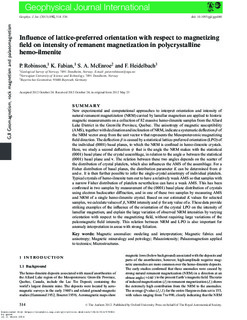| dc.contributor.author | Robinson, P. | |
| dc.contributor.author | Fabian, Karl | |
| dc.contributor.author | McEnroe, Suzanne | |
| dc.contributor.author | Heidelbach, F | |
| dc.date.accessioned | 2018-03-12T08:36:13Z | |
| dc.date.available | 2018-03-12T08:36:13Z | |
| dc.date.created | 2012-12-11T15:18:19Z | |
| dc.date.issued | 2012 | |
| dc.identifier.citation | Geophysical Journal International. 2013, 192 (2), 514-536. | nb_NO |
| dc.identifier.issn | 0956-540X | |
| dc.identifier.uri | http://hdl.handle.net/11250/2490026 | |
| dc.description.abstract | New experimental and computational approaches to interpret orientation and intensity of natural remanent magnetization (NRM) carried by lamellar magnetism are applied to historic magnetic measurements on a collection of 82 massive hemo-ilmenite samples from the Allard Lake District in the Grenville Province, Quebec. The anisotropy of magnetic susceptibility (AMS), together with declination and inclination of NRM, indicate a systematic deflection β of the NRM vector away from the unit vector v that represents the Mesoproterozoic magnetizing field direction. The deflection β is caused by a statistical lattice-preferred orientation (LPO) of the individual (0001) basal planes, to which the NRM is confined in hemo-ilmenite crystals. Here, we study a second deflection ψ that is the angle the NRM makes with the statistical (0001) basal plane of the crystal assemblage, in relation to the angle α between the statistical (0001) basal plane and v. The relation between these two angles depends on the scatter of the distribution of crystal platelets, which also influences the AMS of the assemblage. For a Fisher distribution of basal planes, the distribution parameter K can be determined from ψ and α. It is then further possible to infer the single-crystal anisotropy of individual platelets. Typical crystals of hemo-ilmenite turn out to have a relatively weak AMS so that samples with a narrow Fisher distribution of platelets nevertheless can have a weak AMS. This has been confirmed in two samples by measurement of the (0001) basal plane distribution of crystals using electron backscatter diffraction, and in one of these two samples by measuring AMS and NRM of a single hemo-ilmenite crystal. Based on our estimated K values for selected samples, we calculate values of β, NRM intensity and ψ for any value of α. These data provide striking examples of the influence of the orientation of the crystal LPO on the intensity of lamellar magnetism, and explain the large variation of observed NRM intensities by varying orientation with respect to the magnetizing field, without requiring large variations of the paleomagnetic field intensity. This relation between NRM and LPO is also important for anomaly interpretation in areas with strong foliation. | nb_NO |
| dc.language.iso | eng | nb_NO |
| dc.publisher | Oxford University Press (OUP) | nb_NO |
| dc.title | Influence of lattice-preferred orientation with respect to magnetizing field on intensity of remanent magnetization in polycrystalline hemo-ilmenite | nb_NO |
| dc.type | Journal article | nb_NO |
| dc.type | Peer reviewed | nb_NO |
| dc.description.version | publishedVersion | nb_NO |
| dc.source.pagenumber | 514-536 | nb_NO |
| dc.source.volume | 192 | nb_NO |
| dc.source.journal | Geophysical Journal International | nb_NO |
| dc.source.issue | 2 | nb_NO |
| dc.identifier.doi | 10.1093/gji/ggs046 | |
| dc.identifier.cristin | 971393 | |
| dc.description.localcode | © The Authors 2012. Published by Oxford University Press on behalf of The Royal Astronomical Society. | nb_NO |
| cristin.unitcode | 194,64,90,0 | |
| cristin.unitname | Institutt for geovitenskap og petroleum | |
| cristin.ispublished | true | |
| cristin.fulltext | original | |
| cristin.qualitycode | 2 | |
